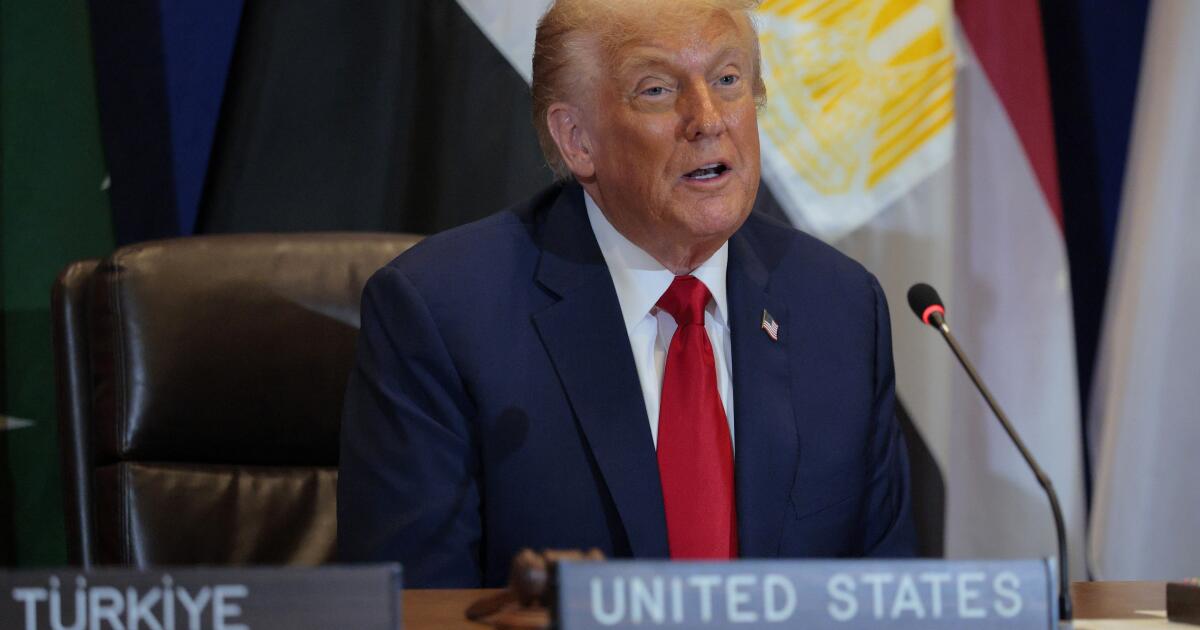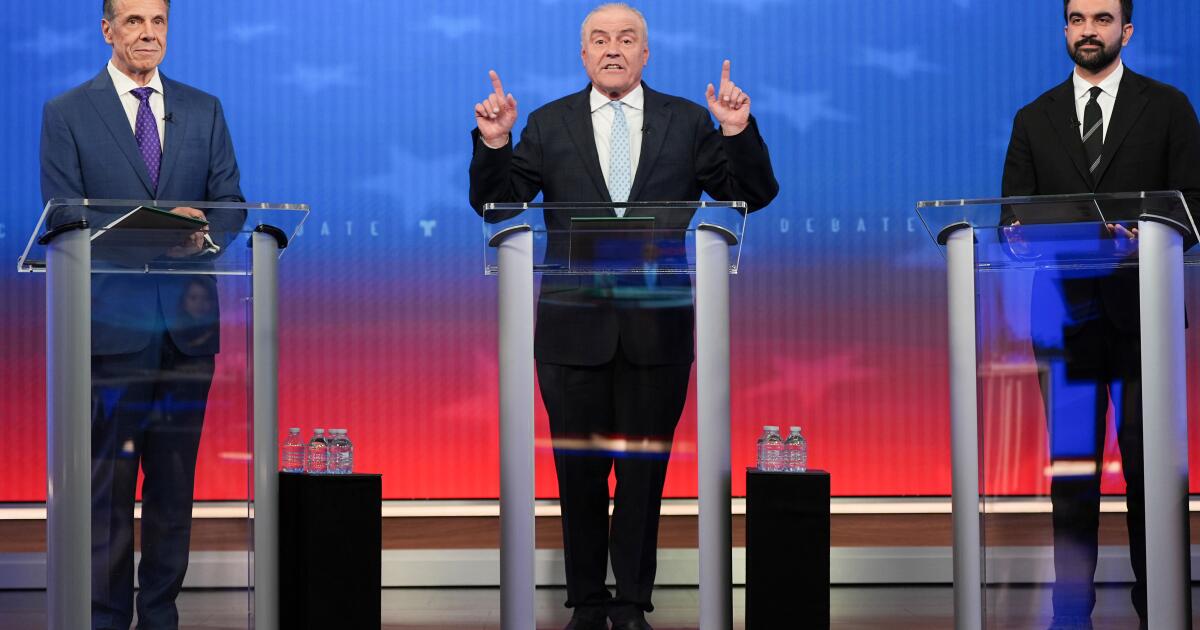Trump ran an ‘America first’ campaign. Now he views presidency as ‘worldwide’
WASHINGTON — On the campaign trail, Donald Trump was unapologetic about putting America first. He promised to secure the nation’s borders, strengthen the domestic workforce and be tough on countries he thought were taking advantage of the United States.
Now, 10 months into his second term, the president is facing backlash from some conservatives who say he is too focused on matters abroad, whether it’s seeking regime change in Venezuela, brokering peace deals in Ukraine and Gaza or extending a $20-billion currency swap for Argentina. The criticism has grown in recent days after Trump expressed support for granting more visas to foreign students and skilled immigrant workers.
The cracks in the MAGA movement, which have been more pronounced in recent weeks, underscore how Trump’s once impenetrable political base is wavering as the president appears to embrace a more global approach to governing.
“I have to view the presidency as a worldwide situation, not locally,” Trump said this week when asked to address the criticism at an Oval Office event. “We could have a world that’s on fire where wars come to our shores very easily if you had a bad president.”
For backers of Trump’s MAGA movement, the conflict is forcing some to weigh loyalty to an “America first” ideology over a president they have long supported and who, in some cases, inspired them to get involved in the political process.
“I am against foreign aid, foreign wars, and sending a single dollar to foreign countries,” Rep. Marjorie Taylor Greene (R-Ga.), who in recent weeks has become more critical of Trump’s policies, said in a social media post Wednesday. “I am America First and America Only. This is my way and there is no other way to be.”
Beyond America-first concerns, some Trump supporters are frustrated with him for resisting the disclosures about the late convicted sex offender Jeffrey Epstein and his network of powerful friends — including Trump. A group of Republicans in the House, for instance, helped lead an effort to force a vote to demand further disclosures on the Epstein files from the Justice Department.
“When they are protecting pedophiles, when they are blowing our budget, when they are starting wars overseas, I’m sorry, I can’t go along with that,” Rep. Thomas Massie (R-Ky.) said in a CNN interview. “And back home, people agree with me. They understand, even the most ardent Trump supporters understand.”
When asked to respond to the criticism Trump has faced in recent weeks, the White House said the president was focused on implementing “economic policies that are cutting costs, raising real wages, and securing trillions in investments to make and hire in America.”
Mike Madrid, a “never Trump” Republican consultant, believes the Epstein scandal has sped up a Republican backlash that has been brewing as a result of Trump deviating from his campaign promises.
“They are turning on him, and it’s a sign of the inviolable trust being gone,” Madrid said.
The MAGA movement was not led by a policy ideology, but rather “fealty to the leader,” Madrid said. Once the trust in Trump fades, “everything is gone.”
Criticism of Trump goes mainstream
The intraparty tension also has played out on conservative and mainstream news outlets, where the president has been challenged on his policies.
In a recent Fox News interview with Laura Ingraham, Trump was pressed on a plan to give student visas to hundreds of thousands of Chinese students, a move that would mark a departure from actions taken by his administration this year to crack down on foreign students.
“I think it is good to have outside countries,” Trump said. “Look, I want to be able to get along with the world.”
In that same interview, Trump said he supports giving H-1B visas to skilled foreign workers because the U.S. doesn’t have workers with “certain talents.”
“You can’t take people off an unemployment line and say, ‘I’m going to put you into a factory where we’re going to make missiles,’” Trump argued.
Trump in September imposed a $100,000 fee for H-1B visas for skilled workers, a move that led to confusion among businesses, immigration lawyers and H-1B visa holders. Before Trump’s order, the visa program had exposed a rift between the president’s supporters in the technology industry, which relies on the program, and immigration hard-liners who want to see the U.S. invest in an American workforce.
A day after Trump expressed support for the visa program, Homeland Security Secretary Kristi Noem added fuel to the immigration debate by saying the administration is fast-tracking immigrants’ pathway to citizenship.
“More people are becoming naturalized under this administration than ever before,” Noem told Fox News this week.
Laura Loomer, a far-right activist and close ally of Trump, said the administration’s position was “disappointing.”
“How is that a good thing? We are supposed to be kicking foreigners out, not letting them stay,” Loomer said.
Polling adds on the heat
As polling shows Americans are growing frustrated with the economy, some conservatives increasingly blame Trump for not doing enough to create more jobs and lower the cost of living.
Greene, the Georgia Republican, said on “The Sean Spicer Show” Thursday that Trump and his administration are “gaslighting” people when they say prices are going down.
“It’s actually infuriating people because people know what they’re paying at the grocery store,” she said, while urging Republicans to “show we are in the trenches with them” rather than denying their experience.
While Trump has maintained that the economy is strong, administration officials have begun talking about pushing new economic policies. White House economic advisor Kevin Hassett said this week that the administration would be working to provide consumers with more purchasing power, saying that “we’re going to fix it right away.”
“We understand that people understand, as people look at their pocketbooks to go to the grocery store, that there’s still work to do,” Hassett said.
The acknowledgment comes after this month’s elections in key states — in which Republicans were soundly defeated — made clear that rising prices were top of mind for many Americans. The results also showed Latino voters were turning away from the GOP amid growing concerns about the economy.
As Republicans try to refocus on addressing affordability, Trump has continued to blame the economic problems on former President Biden.
“Cost, and INFLATION, were higher under the Sleepy Joe Biden administration, than they are now,” Trump said in a social media post Friday. He insisted that under his administration costs are “tumbling down.”

